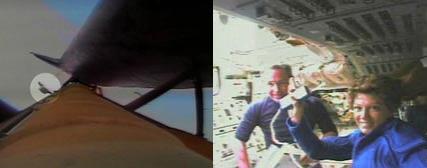
The astronauts on the shuttle Discovery are entering their routine, but in a short time they too will retire to sleep to begin preparations for tomorrow's (Thursday) rendezvous with the International Space Station. Meanwhile, NASA television mainly broadcasts voice conversations with the astronauts aboard Discovery and occasionally switches to a fragmented television broadcast when the shuttle is over the western United States, where there are experimental listening devices designed to bypass the satellite network in case of emergency. This time it is not an emergency, and the shuttle's satellite antenna is scheduled to open later, around noon Israel time. Then the continuous broadcast will also begin.
From the conversations between the control center and the crew members of the spacecraft, headed by the commander Eileen Collins, it appears that the astronauts are busy with the routine tasks of the beginning of a journey, including the preparation of the photo arrays, the release of the robotic arm and the initial activation of various systems inside the passenger compartment of the space shuttle Discovery.
The shuttle will also ignite its engines tonight to bring it closer to the orbit of the International Space Station in order to reach above it.
During the post-launch press conference, NASA leaders cheered for the successful launch. "The countdown was completely smooth," said Shuttle Launch Manager Michael Leinbach, who watched the launch from the Kennedy Space Center control room. "The mood was giddy. We tapped each other on the shoulder."
"My heart jumped to my throat this morning." said shuttle program deputy director Wayne Hale. "It was a great day."
During the first eight minutes, Discovery accelerated to a speed of approximately 28 km/h on its journey to rendezvous with the International Space Station at an altitude of approximately 400 km above the Earth.
The spacecraft burned through all the fuel in the solid propellant boosters and the liquid propellant tank before settling into a relatively low elliptical orbit.
The mission commander, Eileen Collins, described the launch as smooth and the feeling of the crew as excellent. "I couldn't have asked for a better flight," she said in a call from space.
The countdown was so smooth that NASA says there was no sign of a fuel sensor problem like the one that delayed the launch two weeks ago.
As mentioned earlier, NASA referred to the claim regarding the fall of two large blocks right after the launch, and its leaders said that the radar did not detect anything, which leaves the possibility that these were harmless objects - apparently large pieces of paper stuck on the engines (see link to the news previous).
Additional updates - during the day, at least every six hours.
